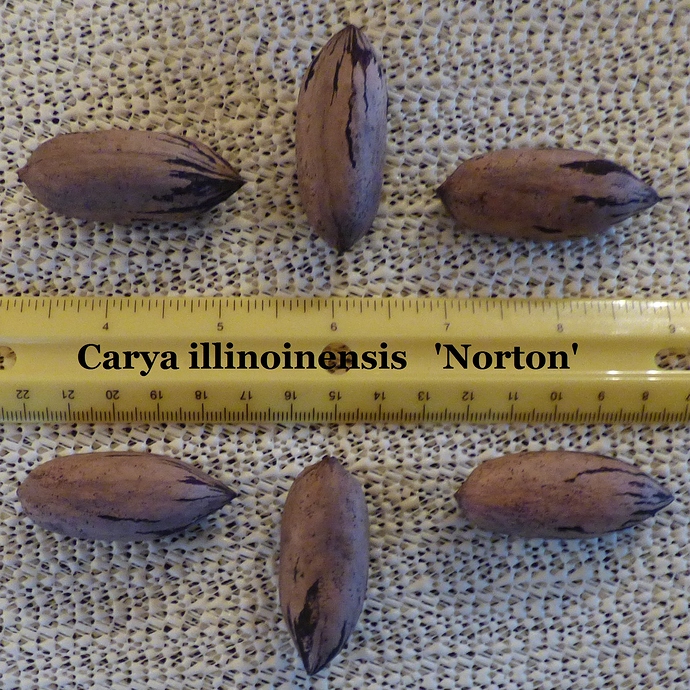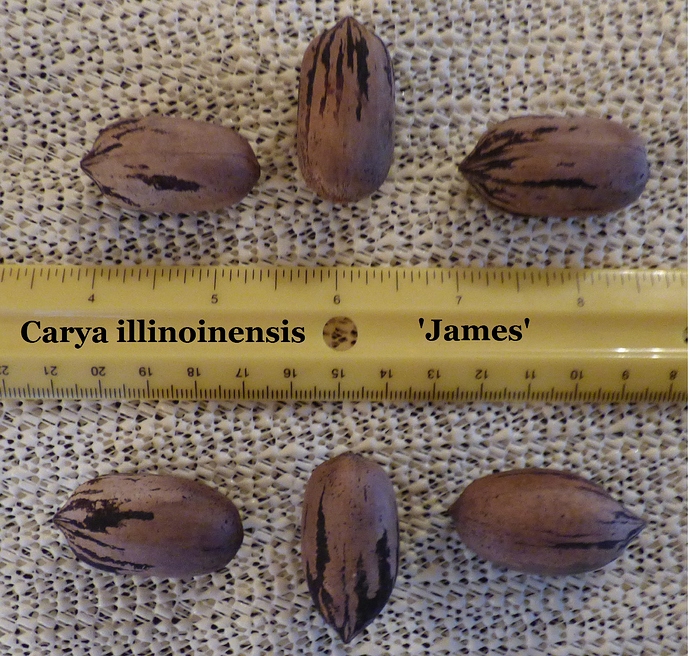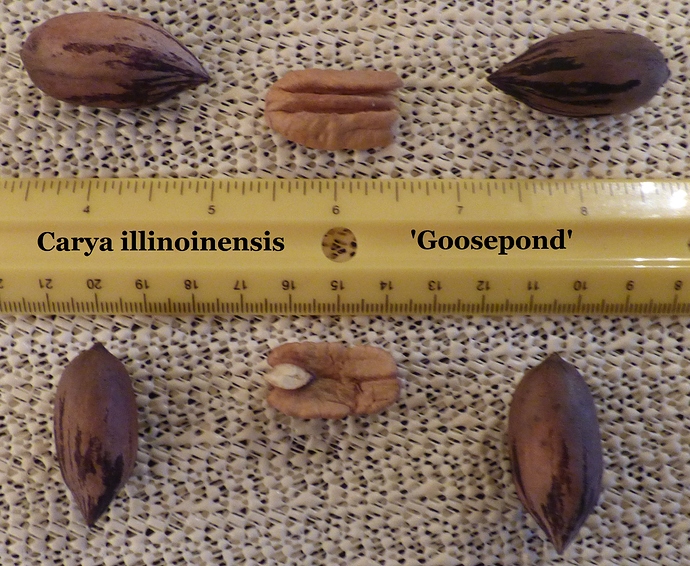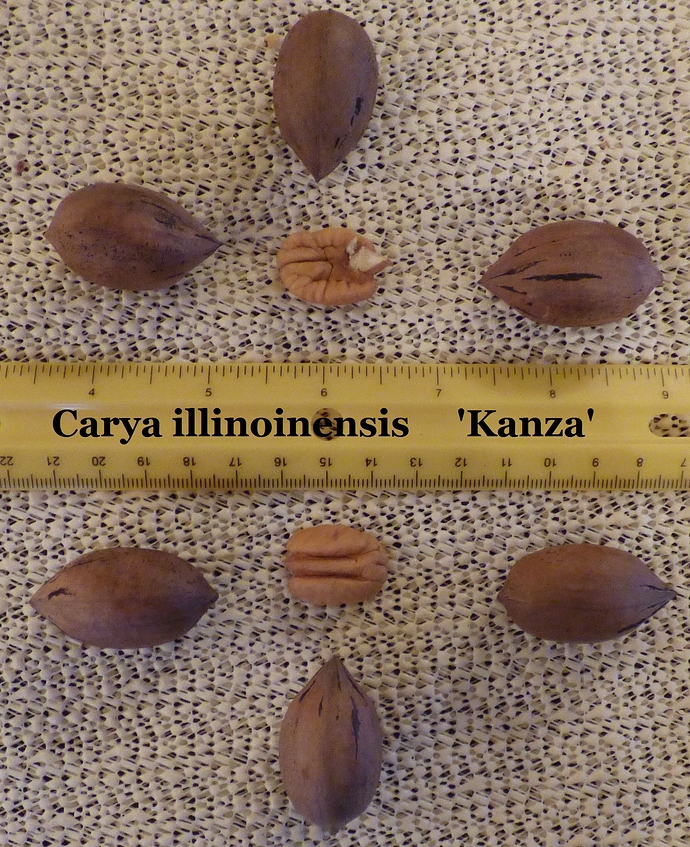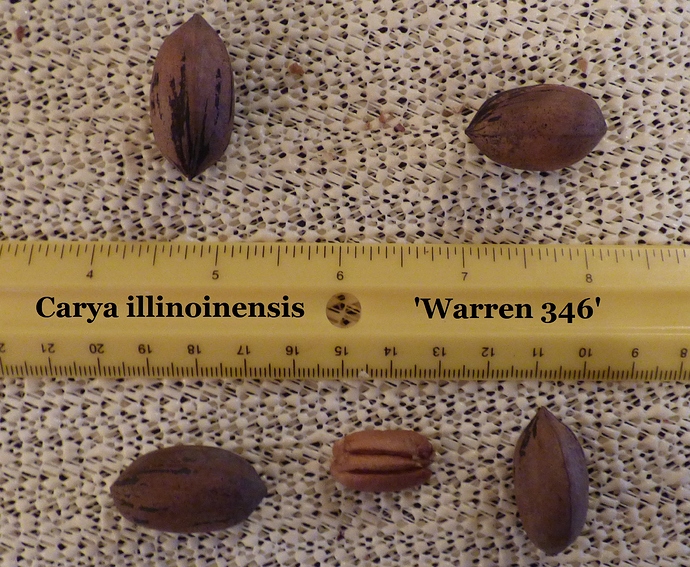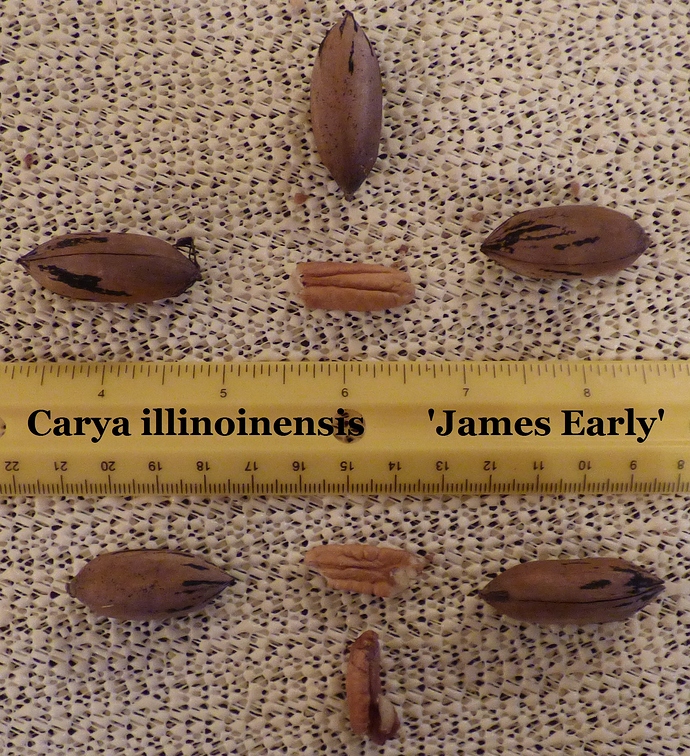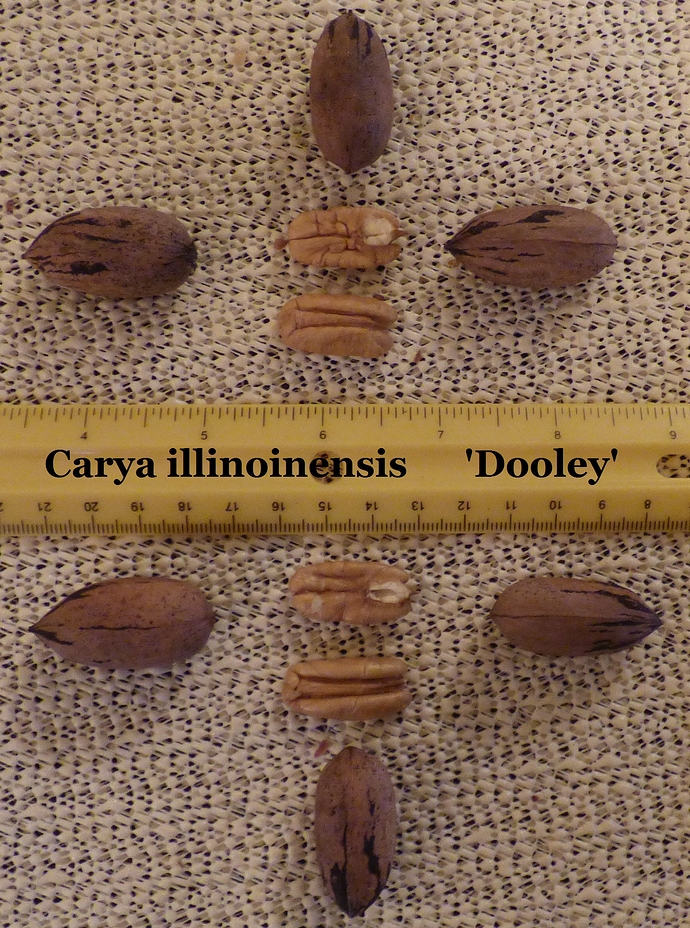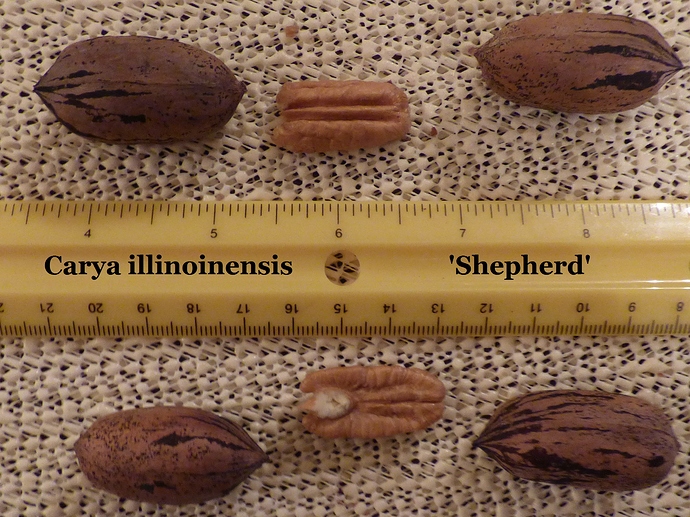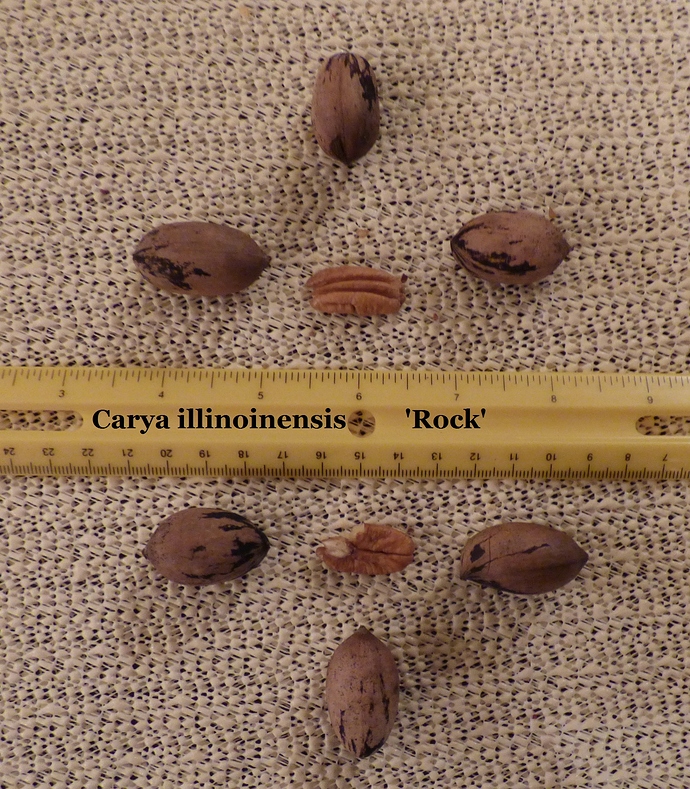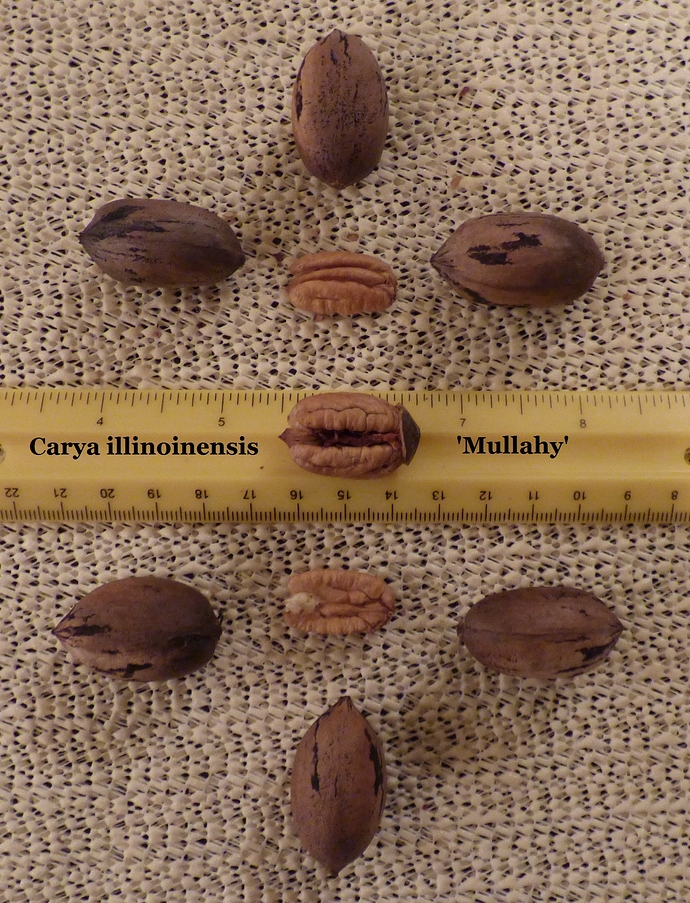Well I’m just going to use Wes’ book along with what I know off the top of my head:
First of all, Wes’ categorizes pecans as Northern or Ultra Northern. There’s an in-between where I live and that’s far northern.
James: Northern to Ultra-Northern (Wes)
My opinion is that it is a Far-Northern pecan that was found at the top of the Northern range and some years it will crop in zone 4b but definitely not consistently.
Starking Hardy Giant: Ultra-Northern (Wes)
My opinion is that it is a far northern pecan that will have years where it will produce in zone 4b (not consistently)
Mullahy: Ultra-Northern (Wes)
My opinion is Far-Northern to Ultra-Northern (not consistent in Ultra Northern zone 4’s)
Dumbell Lake Best aka Dumbell Lake Small: no area selection from Wes.
It is a Far Northern to Ultra Northern (not consistent in Ultra-Northern zone 4’s)
Gibson: Ultra-Northern (Wes)
If is a Far-Northern to Ultra-Northern (not consistent in Ultra-Northern zone 4’s)
Green Island Beaver aka Cornfield: Ultra Northern (Wes)
Far-Northern to Ultra-Northern (very good for Ultra-Northern; its shuck split is -18 days before ‘Colby’)
Warren 346: very hardy and a consistent producer for zone 4b/4a? Wes calls this category 1. (-21 days before ‘Colby’ and is “Ultra-Northern”).
(Wes Rice)
“Category 1 - Early ripening cultivars with superior qualities. This category includes cultivars that have very early nut maturity, trees withstanding conditions as far north as Agricultural Zone 4, and produce crops that ripen frequently. Some selections are likely as good as the top rated cultivars, but have yet to be tested adequately. Nuts typically yield flavorful kernels, and cracking quality is good.”
Martzan (Category 1) Ultra-Northern (-19 days before 'Colby)
Snaps Early (Category 1) Ultra-Northern (probably -19 to -21 days prior to ‘Colby’ because it’s predicessor ‘Snaps’ is -17 prior to ‘Colby’).
Carlson 3 (Category 1) Ultra-Northern (-17 days before ‘Colby’)
Lucas (Category 1) Far-Northern to Ultra-Northern (-11 days prior to ‘Colby’)
Campbell NC4 (Category 1) Far-Northern to Ultra-Northern (-9 days prior to ‘Colby’)
I mostly-agree with Wes. Lucas & Campbell NC4 are borderline at least how I see it as being Ultra-Northern. (? ask Wes).
(Wes Rice)
“Category 2 - Early ripening cultivars with good qualities. This category represents selections that are somewhat less cold hardy than those listed above, and require on average, a longer growing season for the crop to ripen. Most have been tested widely enough that their strengths and weaknesses are documented.”
Canton: (Category 2)
My opinion is top of the northern range and okay for Far-Northern. I don’t see this as an Ultra-Northern pecan.
Deerstand: (Cateogry 2)
My opinion is far-northern with some prospects for Ultra-Northern but won’t ripen every year in zone 4b. I know for a fact Grimo Nursery puts it as an Ultra Northern pecan but that’s his opinion and not mine. I believe I’m correct. It’s origin is Burlington IA (right across the river from me) and while Warren 346 is -21 days before Colby, Deerstand is -8 days. thats two weeks difference. Quite a lot I believe when talking about zone 4/“Ultra-Northern.”
Devore: (Category 2)
Never heard of it. It’s -2 days (after ‘Colby’ however) so at most it’s Far-Northern and not Ultra-Northern for me.
It is however a direct line from my house, but, its shuck split is late for Ultra Northern is my opinion. I suppose in the best zone 4 year (1 in 5 or 1 in 10 years) it could produce great____ best I can say.
Fisher: (Category 2) shuck splits with ‘Colby’. Far-Northern and not Ultra-Northern… just as Wes says.
Hadu #2: (Category 2) -6 days before Colby. This is going to be a Far-Northern selection with some but very limited potential for Ultra-Northern. The season just isn’t long enough for Ultra-Northern areas.
Bolten’s S-24: (Category 2) origin is Near Terre Haute, IN. That alone tells me it’s maximum potential is Far-Northern. It is -7 days to ‘Colby’. It falls into Northern to Far-Northern.
(Wes Rice)
“Category 3 - Sub-northern cultivars This category includes cultivars that are usually successful in Agricultural zone 6, and may live and produce nuts in Zone 5 on a less regular basis. Kernel properties and cracking are typically good.”
Yates 152: (Category 3)
My friend has never mentioned trying to grow it up here. It’s doubtful to be productive just as Wes says. This is a Northern selection.
Goosepond: (Category 3)
We are grafting it here in the pecan Far-Northern range. I don’t find the kernels all that excellent and I wouldn’t grow it when ‘Hark’ is already a sure shoe in. Nevertheless, we are going to find out one way or another if it bears here.
Shepherd: (Category 3)
The nuts it is producing here are quite smaller than when grown in the Northern pecan belt. However, we know it is pollinating itself and we’ve only had two years to evaluate. It certainly produces in the Far-Northern pecan belt.
Witte: (Category 3)
Local selection right across the river from here. Shuck split is same as ‘Colby’. I’ve not seen a nut of ‘Colby’ grown here but I suspect it will grow here. Size may be quite small I don’t know.
a side-note is that ‘Gibson’ here produces nuts so small (it overbears for one) that they aren’t much larger than the last knuckle on your pinky to the end of your fingernail.
Yates 127: (Category 3)
It’s a Northern pecan. Whether it shuck splits here is likely just as Wes categorizes it (not consistently).
Yates 68: (Category 3)
Ditto.
(Wes Rice)
Category 4 - Poor Performers This category includes cultivars which, based on my observations and opinions, have few redeeming qualities. Nut maturity dates, disease resistance, nut size, and tree characteristics deem these cultivars as poor selections for propagation.
Dumbell Lake other aka Dumbell Lake Large: (Category 4)
It is a selection right across the river from me and that puts it in the Far-Northern range. Its shuck split is the same as ‘Colby’. It is not going to be an Ultra-Northern selection whereas ‘Dumbell Lake Best aka Dumbell Lake Small’ has some but not a lot potential for inconsistent cropping/shuck split in the Ultra-Northern range.
**Dumbell Lake Best aka Dumbell Lake Small refers to the size of the tree and not the size of the nut. It’s an error on my friends part to differentiate the two while collecting scionwood. So the (2) Dumbell Lake (large/small) has nothing to do with the nut-size.
Green Island Hackberry: (Category 4)
It is a Far-Northern selection that likely will not mature nuts in the Ultra-Northern pecan range. It is -6 days prior to ‘Colby’ for shuck split.
Snag: (Category 4)
Absolutely Ultra-Northern. Its shuck split is -17 days prior to ‘Colby’. Even if nut quality size is small, it’s likely going to be much better than seedling pecans for the Ultra-Northern range. As you go further north, disease impact is much less if none-at-all. So for the zone 4 folks it’s one to look for. It’s origin is right across the river from me (Burlington, Iowa).
Theresa Foster: (Category 4)
2 days + ‘Colby’. Certainly a Northern cultivar with potential in the Far-Northern range. It’s a Missouri-selection.
Ralf Upton: (Category 4)
-6 days before ‘Colby’. It’s fits directly to the Far-Northern range. As to Ultra-Northern, again, maybe 1 out of every 5 or 10-years it could be worthwhile.
Woman aka Old Woman: (Category 4)
Found directly across the river from here (Burlington, Iowa). -6 days before ‘Colby’ & is definitely a Northern-Pecan w/o much potential at all for Ultra-Northern areas.
Additional Information.
(Wes Rice: Pecans - Volume II A Grower’s Perspective) pg. 94
Next is Northern Cultivars some of which have been covered above. And with your help, Darrel, Northern cultivars are going to be a combination of both’ our knowledge. You are likely to know more about them than I.
Best,
Dax



